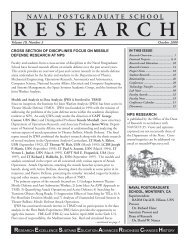Spectral Unmixing Applied to Desert Soils for the - Naval ...
Spectral Unmixing Applied to Desert Soils for the - Naval ...
Spectral Unmixing Applied to Desert Soils for the - Naval ...
Create successful ePaper yourself
Turn your PDF publications into a flip-book with our unique Google optimized e-Paper software.
The target material shows up in various regions associated with what appears <strong>to</strong><br />
be steeper terrain and <strong>the</strong> sides of drainages where unconsolidated material often appears;<br />
corresponding <strong>to</strong> <strong>the</strong> conditions of <strong>the</strong> material during collection. This endmember was<br />
given a slightly different margin <strong>for</strong> MF and infeasibility scores (closer <strong>to</strong> 5 and 10,<br />
respectively) because unconsolidated material is expected <strong>to</strong> be mixed with o<strong>the</strong>r material<br />
such as vegetation and different mineral mixtures. There<strong>for</strong>e, you would expect <strong>the</strong> pixel<br />
percentages <strong>to</strong> potentially be lower.<br />
For <strong>the</strong> repeatability test, <strong>the</strong> f110512t01p00r08 data set also had positive matches<br />
<strong>to</strong> targets. In this test, however, <strong>the</strong>re were significantly fewer pixels identified with<br />
feasible mixtures (Figure 33). Since <strong>the</strong>re were so few pixels identified under <strong>the</strong><br />
standard ranges, <strong>the</strong> scatter plot class was increased <strong>to</strong> encompass MF scores <strong>to</strong> 52 (<strong>the</strong><br />
highest possible range, and as low as 5. Even <strong>the</strong>n most of <strong>the</strong> pixels were concentrated<br />
in certain areas ra<strong>the</strong>r than distributed throughout <strong>the</strong> imagery as seen in <strong>the</strong><br />
f110512t01p00r07 data set. This is a good result however, considering <strong>the</strong> terrain is very<br />
flat in most of this image. Areas where <strong>the</strong> endmember corresponds <strong>to</strong> flat areas appear<br />
<strong>to</strong> be areas of runoff in both <strong>the</strong> imagery and looking at Google Earth. The high<br />
concentrations of areas determined <strong>to</strong> be target material are again associated with regions<br />
of steep terrain where you would expect loosely consolidated material. The majority of<br />
those regions are located, in most instances, around <strong>the</strong> edges of <strong>the</strong> landscape features<br />
depicted in Figure 33. These main imagery features appear <strong>to</strong> be highly lithified rock<br />
structures in <strong>the</strong> imagery and are confirmed as such <strong>to</strong> <strong>the</strong> greatest possible extent using<br />
Google Earth. The areas where <strong>the</strong> target material has been identified do appear <strong>to</strong> be<br />
steeper regions with less consolidated surface material as well as deposits at <strong>the</strong> base of<br />
<strong>the</strong> structures.<br />
65
















